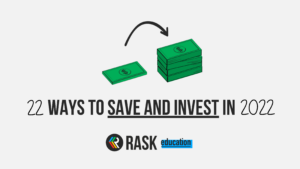This article covers getting a Tax File Number (TFN) in Australia, along with key terms like ATO, Income Tax, GST, CGT and Stamp Duty.
As we leave school and start figuring out how to successfully adult, we’re quickly reminded of the two fundamentals of life: death & taxes. Unless you decide to become a hermit in regional Australia with no reliance on the Australian workforce or financial system, dealing with tax is mostly unavoidable (especially if you’re here because you’re interested in investing).
Whether you currently think you’re paying too much tax or not enough, there’s some level of mutual agreement in Australia that some level of taxes are required to run a country and make sure we don’t leave people behind.
There’s lots of different taxes applicable to different individuals and companies, but the ones that you’re probably familiar with are income tax (that your employer takes out of your salary), GST (it’s at the bottom of all your Woolies receipts) and stamp duty (because what Aussie hasn’t heard about property).
I’m going to kick it off with those three, and then introduce you to a few more things that investors should be aware of throughout this article.
Let’s look at everyone’s favourite government regulator to start with.
What does the Australian Tax Office (ATO) do?
The Australian Tax Office (ATO) is the area of the government responsible for making sure individuals, businesses, self-managed super funds and other entities lodge their taxes each year. Each person and business is responsible for lodging their own tax return, usually for the year to June 30th.
In addition to monitoring and collecting taxes, the ATO works with other parties like APRA and ASIC to maintain Australia’s highly regulated financial system.
That leads me onto the next important point – how does the ATO keep track of you?
Getting a Tax File Number (TFN)
The ATO keeps track of individuals using Tax File Numbers (TFNs). Everyone can apply for a TFN and it follows you around to the grave. When you get a new job, Super fund, investment account or bank account, you’ll usually be asked to provide your TFN.
While it’s not illegal to withhold providing it, the provider may need to tax you at the highest rate, and you’ll have to claim the withheld tax back at the end of the financial year (EOFY).
You can apply for a TFN through the following methods:
Learn more about applying for a TFN in different scenarios on the ATOs website.
Important taxes to be aware of in Australia
Now that you’re paying tax like a fully fledged adult, here are some common taxes you should be aware of (especially as an investor).
Income Tax
Income tax is a tax on any income you earn through your work and investments. This may include the money you earned from your 9-5 employer, additional money earned by side hustlin’ on the weekend, bank interest and that juicy $5 dividend you got earlier this year. The ATO has a great breakdown of what counts as assessable income here.
When you get a new job, your employer will get you to fill in a TFN Declaration Form, and they’ll report this information to the ATO.
If you don’t provide this declaration to your employer, they may need to withhold tax from your salary at the highest rate, which you can then claim back at the end of each financial year. This form will also give you options to claim the tax free threshold, nominate your residency status and declare if you have any form of student debt.
If you receive income from any shares, ETFs, managed funds etc. that you own, this will also need to be declared on your annual tax return. Income tax is payable on this money as well.
Goods and Services Tax (GST)
Have you ever looked at your Woolies or Bunnings receipt and saw that the line above the total purchase price you paid mentioned GST 10% or GST included in the total with a dollar amount next to it?
Goods and services tax (GST) is a tax of 10% charged on a broad range of goods and services in Australia. Most businesses incorporate the tax into the price you see on the tag, so you don’t have to think about it. The businesses then pay most of this money to the ATO on a regular basis.
As an individual you won’t need to think about GST too much, but if you’re getting quotes from tradespeople or getting custom services, it’s a good idea to ask if the total includes GST (otherwise you might be in for a surprise 10% increase in costs).
Stamp Duty
Here’s one for all the property lovers out there…
Another tax to be aware of is the stamp duty (otherwise known as land transfer duty) tax. This tax, however, varies between states and territories, so it’s certainly not one size fits all. It’s a tax that’s generally paid upfront when you purchase a property and it transfers from one owner to another.
Kate’s Tip: Search for your own state government’s website to find more details about stamp duty in your state, and the various subsidies available.
Capital Gains Tax (CGT)
And saving the best to last, every investor’s best friend, Capital Gains Tax (CGT). Although your capital gains are added to your assessable income each year, I think CGT is worth addressing separately.
If you made money off that hot stock your neighbour told you about earlier this year and sold it feeling very pleased with yourself, you can’t run off and spend it all just yet. The ATO expects you to share some of your profits with them, and if you don’t put enough cash aside you might end up in a dicey situation come tax time.
CGT generally kicks in when you sell an asset (e.g. share, ETF, managed fund, investment property etc.) and make a capital gain (of course, making a capital loss is always on the cards as well).
Capital Gain = Total Sale Amount – Original Purchase Amount (Cost Base)
As per the ATO’s CGT guide, “individuals and small businesses (excluding companies) can generally discount a capital gain by 50% if they hold the asset for more than one year”.
You’ll declare and pay CGT as part of your income tax return each year (but the ATO generally knows if you’ve made some capital gains during the year). You can generally use any capital losses to offset capital gains in your income tax return.
Well that was quite a mouthful! If you’re keen to learn more about any of these areas, I’d highly recommend going directly to the ATO’s website.



